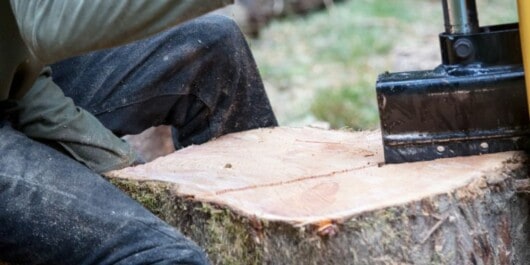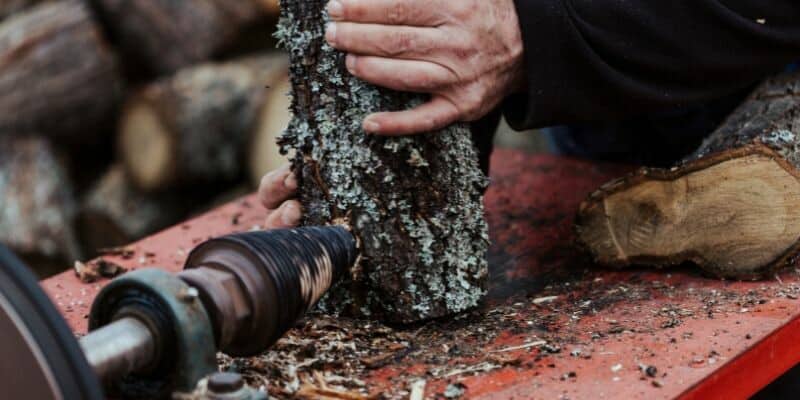Are you a homeowner looking to purchase a manual log splitter, but first want to know all about using a manual log splitter? If so, then you’re definitely in the right place.
Using a manual log splitter is actually simpler than people think. Instead of using power to drive the piston from gas or electricity, you will be responsible for providing all the input to the log splitter. A manual log splitter is any kind of product that’ll help you split a log by using the force generated by you instead of some kind of hydraulic force. Manual log splitters are almost as effective and reliable as electricity or gas-powered log splitters.
In this article, you will get to know all about manual log splitters, different types of manual log splitters, how to use a manual log splitter, different reasons to use a manual log splitter, and more. Continue reading to get all the answers that you’re looking for.
What is a manual log splitter?
If you have tried cutting a log of wood using an axe, you will know that it is considerably harder than it looks. Even looking to split a small pile of wooden logs for your fire pit can be exhausting if done the old-fashioned way, and this is why most homeowners favor the use of log splitters these days.
Manual log splitters come in different guises, from simple axes and metal wedges to huge machines. If you haven’t decided on the type of manual log splitter you would like to buy, then this article will be of great help to you.
There is nothing quite like having the time to enjoy a warm, soothing fire during winter. While a manual log splitter will make the task easy, there are different ways of manually splitting logs, all of which come with their own charm.
Reasons for using manual log splitter tools
There are a number of practical reasons to use some kind of manual log splitters. The most prominent ones include – affordability, great for exercise, and environmentally responsible. The biggest draw of a handheld log splitter tool is its low cost. Splitting logs manually might cost you time, but it’ll save you the upfront cost of the manual log splitter.
How to use a handheld log splitter will depend on only one power source – you. By draining neither gasoline fuel nor electricity, manual log splitting tools will prove themselves to be the most environmentally friendly tools. Moreover, when you’re using a manual log splitter, you will never have to worry about running out of fuel or losing power in case of a power outage.
Finally, even though you’ll certainly find better exercise programs to target your abs and quads, it can be hard to deny that using handheld tools for splitting logs will provide a great workout. Just make sure that you stop when you’re tired and be mindful of the strain that is placed on your joints and back.
What are the different types of manual log splitters?
The different types of tools that you can use for splitting logs manually will range from simple tools with a single part to dynamic tools with many moving components.
Splitting Axe
As opposed to what you may have learned from cartoons, you cannot just pick up any old axe and use it for chopping firewood. To split wooden logs into firewood-sized pieces, you’ll require a splitting axe.
Unlike a felling axe, which will cut wood fibers short and will be suited for chopping trees down, a splitting axe is designed for wedging its way between wood fibers and forcing them apart. Lightweight, a short handle, and with a thin blade, a splitting axe will be a popular choice for splitting small logs.
Wedge and sledgehammer
If swinging a sharp tool overhead isn’t appealing enough for you, you’ll still be able to enjoy splitting logs manually by using a sledgehammer. It’ll allow you to drive a one-piece wedge into a log.
While one person can hold the wedge in place, another one taps it into the log, which is similar to using a hammer to tap a nail into a board. After that, once the wedge is set, one person will strike the wedge with the sledgehammer and split the log apart. Using a wedge and a sledgehammer will be a time-intensive two-person job, but it’ll still be a budget-friendly option.
Splitting maul
A splitting maul will combine the best parts of a sledgehammer and a splitting axe. Even though the edge of a blade is thin and sharp, the back of the maul’s head is wide and weighty enough to drive the blade’s edge into the wood quickly. A splitting maul weighs more and will have longer handles compared to splitting axes, improving them suited for larger logs.
Sliding manual log splitters
If you don’t wish to use a powered log splitter but want your log splitter to do most of the moving, then a sliding manual log splitter will be the right option for you.

This type of tool feature a wedge attached to a pole, which slides up and down another pole. The kinetic energy will drive the wooden fibers apart. However, you shouldn’t think that your options are limited, as some models are capable of applying up to 14 tons of force.
Manual hydraulic log splitters
You will find a lot of electricity and gas-powered log splitters that make use of hydraulic pistons for driving a wedge into a log. If this appeals to you, but you still want to avoid tools that utilize external power sources, then you may be interested in using a manual hydraulic log splitter.
Instead of obtaining the power to drive the piston from electricity or gas, a hydraulic manual log splitter will require you to pump a set of handles. The resulting force will push the wedge through the wood and split it apart.
How good are manual log splitters?
Manual log splitters may require slightly more labor compared to other types of log splitters, but they are definitely a great option if you’re looking to find a way to get the firewood done for the winter. In fact, a manual log splitter is a tremendous option for lower volume wood splitting, such as what will be required for hiking, camping, or minimal home use.
There are a few manual log splitters that are more portable than others, which plays a key role in the overall diameter of the wood that you can split. You should keep in mind that when using a manual log splitter, you’re going to require direct manpower to complete your job.
There are a few safety issues if you are not careful about where you’ve got your hands positioned. Hands are the most common victims when it comes to injuries afflicted when operating manual log splitters. Of course, if you’re attentive at all times and take the right safety measures, you won’t have to worry about this anyway.
How to use a manual log splitter
Using a manual log splitter is rather simple. Here are the steps that you’ll need to follow –
1. Move the manual log splitter near the wood
Dragging and hauling the logs around to the manual log splitter is tedious, time-consuming, and can injure your back. Instead, you should take the log splitter closer to the work area where you have kept the logs to reduce your workload. Typically, most medium to large models come with large wheels and can be towed or even repositioned easily manually if it is just a few yards.
2. Position the log splitter correctly
One of the most important things that you should remember when using a manual log splitter is that it has to be positioned on a flat, level surface. This will reduce the chances of your machine tipping over, an occurrence that can damage the machine or cause serious injuries to you. Moreover, ensure that you’ve got plenty of room to work around with, stand, and move when operating the machine comfortably.
3. Load the logs
Hold the wooden log on either of the long sides. Do not hold it on the diameter/ends when you are loading the log to your splitting machine. Depending on the machine, you will either need to load the logs horizontally or vertically. For horizontal models, place the wooden log on the bed. For vertical models, you will need to stack it against the splitting wedge.
4. Use the manual log splitter
With the log loaded, you’ll need to start applying manual force to the wooden logs. This way, you will be able to split the logs into two.
5. Remove the split logs
Once you have successfully split your first wooden log, you should remove it from the bed and then repeat the process with the remaining logs until you’re done cutting all the firewood.
Conclusion
Thank you for reading. Hopefully, now you know a lot more about manual log splitters, different types of manual log splitters, how to use a manual log splitter, different reasons to use a manual log splitter, and more. Using a manual log splitter is actually simpler than people think. Instead of using power to drive the piston from gas or electricity, you will be responsible for providing all the input to the log splitter. A manual log splitter is any kind of product that’ll help you split a log by using the force generated by you instead of some kind of hydraulic force. Manual log splitters are almost as effective and reliable as electricity or gas-powered log splitters.


